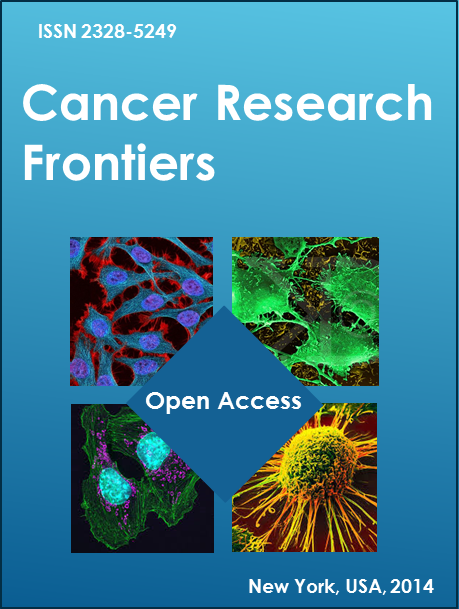Abstract _ Full Text (HTML) _ Full Text (PDF)
Review
Cancer Research Frontiers. 2017; 3(1): 64-71. doi: 10.17980/2017.64
Primary Percutaneous Coronary Interventions in Cancer Patients
Cezar Iliescu1, Despina Tsitlakidou2, Dana Elena Giza1, Konstantinos Marmagkiolis 3
- 1- The Department of Cardiology, the University of Texas MD Anderson Cancer Center, Houston, TX, USA. ,
- 2- Wayne State University, Detroit, MI, USA,
- 3- Florida Hospital, Pepin Heart Institute, Tampa, FL, USA,
*Corresponding author: Konstantinos Marmagkiolis MD, MBA, FACC, FSCAI, Florida Hospital, Pepin Heart Institute, Tampa, FL, USA. 3100 E Fletcher Ave, Tampa, FL 33613. Email:
Citation: Cezar Iliescu, et al. Primary Percutaneous Coronary Interventions in Cancer Patients. Cancer Research Frontiers. 2017; 3(1): 64-71. doi: 10.17980/2017.64
Copyright: @ 2017: Cezar Iliescu, et al. This is an open-access article distributed under the terms of the Creative Commons Attribution License, which permits unrestricted use, distribution, and reproduction in any medium, provided the original author and source are credited.
Competing Interests: The authors declare no competing financial interests.
Received Nov 6, 2016; Revised Mar 27, 2017; Accepted Apr 4, 2017. Published Jun 1, 2017
Abstract
Cardiovascular disease and cancer increasingly coexist, therefore optimum management is required in order to treat the underlying malignancy and to reduce morbidity and mortality associated with cardiovascular diseases. Primary PCI in patients with active cancer and coronary artery disease presents particular challenges for clinicians. Special considerations include radiation and chemotherapy-induced vascular damage, primary or secondary thrombocytopenia, presence of coagulopathies, vascular access complications and increased risk of stent thrombosis. Although PCI is performed in a minority of cancer patients, it is not associated with worse long‐term cardiovascular outcomes. Conservative management of ACS in cancer patients offers poor survival rates. In the majority of cancer patients with acceptable prognosis or cancer survivors, well planned and performed PCI is probably the best option.
Key Words: PCI, STEMI, NSTEMI, myocardial infarction, coronary artery disease, cardiovascular disease
Introduction
Cardiac disease and cancer are two of the leading causes of morbidity and mortality worldwide (1). The optimization of screening, diagnosis and treatment of both diseases has resulted in an increase of cancer survivors with concomitant cardiovascular diseases (2). The high prevalence of coronary artery disease (CAD) in patients with new cancer diagnoses undergoing active oncologic therapy may be due to an overlap in risk factors (eg, age, smoking etc), as well as a predisposition to early atherosclerosis due to certain oncologic treatments, such as radiation or chemotherapy (3). These patients will require medical management and/or invasive cardiovascular treatments, such as percutaneous coronary intervention (PCI). PCI is the preferred therapy for ST Elevation Myocardial Infarction (STEMI), Non ST Elevation Myocardial Infarction (NSTEMI)/unstable angina and stable angina refractory to optimal medical therapy (4). Cancer patients have been previously excluded from most major randomized controlled cardiology trials and details about cancer history are not typically collected in PCI registries, thus the optimal management of patients with cardiac disease and cancer remains unclear. In cancer patients who underwent coronary revascularization, greater than 50% of the deaths are attributed to non-cardiac causes, out of which 20% are related to cancer (5).The management of cardiac disease in cancer patients is challenging due to vascular effects of previous chemotherapy and radiation therapy, coexisting anemia, thrombocytopenia and coagulopathy, as well as the unpredictable cancer recurrence which may require interruption of antiplatelet therapy for urgent biopsies, surgery or re-initiation of cancer therapy. In the general population, patients undergoing PCI are at risk of bleeding from the procedural instrumentation or the use of antiplatelet therapy after stent implantation and/or at risk of thrombosis from PCI-induced vascular injury. In cancer patients these is an even higher risk of bleeding and/or thrombosis as cancer induces a hypercoagulable and pro-inflammatory state (6). There is a growing population of patients with CAD and cancer, therefore further understanding of the impact of PCI on the outcomes of cancer patients with concomitant acute coronary syndrome (ACS) is warranted.
Table 1. Mechanisms of ACS in cancer patients
Mechanisms of coronary artery disease in cancer patients
The mechanism of coronary artery disease (CAD) and acute coronary syndromes (ACS) differs significantly in cancer patients compared to the general population (6). Cancer cells induce the secretion of pro-inflammatory cytokines secretion, which promote endothelial damage and increases microvasculature permeability for pro-coagulating factors (platelet activating factors, tissue factor) (7). In addition, elevated low-density lipoprotein cholesterol particles invade vascular intima forming plaques, which added to the prothrombotic state in cancer increases the overall risk of CAD in cancer patients (8). Moreover, chemotherapy and radiation therapy contribute to the damage of the coronary endothelium and the outer walls. Several chemotherapy agents affect the coronary arteries via different mechanisms (Table 1). 5-FU causes abnormal coronary vasoreactivity, Paclitaxel and Docetaxel severe vasospasm which has been reported to cause ACS. Cisplatin may induce acute coronary thrombosis, even in multiple territories (9). Pathology studies have demonstrated the endothelial dysfunction induced by Bleomycin, endothelial apoptosis by Vinblastine and accelerated atherosclerosis by nilotinib and ponatinib (10). Cyclophosphamide may induce Prinzmetal’s angina and several chemotherapy agents have been identified as causes of Takotsubo cardiomyopathy which can mimic STEMI (11). Interestingly, ionizing radiation affects not only cancerous but also non-cancerous cells, especially those that are rapidly proliferating, including endothelial. Therefore, radiation therapy (RTX), due to the oxidative stress and inflammation triggered, affects the coronary vasculature and may increase the risk of ACS (12). Pathology studies have identified cholesterol plaque formation and thrombosis within days after initiation of radiation therapy in animal models. In patients who have received long-term RTX, fibrosis and later calcification is seen in all three layers of the vessel wall (13). Moreover, radiation also causes abnormal intra-plaque hemorrhage in experimental animal models, which is known to induce atherosclerosis progression, plaque instability and rupture in human atherosclerotic lesions.
The mechanism by which cancer and cancer therapy increases the risk of ACS is multifactorial. Coagulation abnormalities primary associated with the malignancy or secondary as a result of the antineoplastic therapies increases the risk of thrombosis, playing an important role in the pathogenesis of ST elevation myocardial infarction (STEMI) (8).
ACS presentation and management in cancer patients
The clinical presentation of ACS in cancer patients may be complicated in the setting of chemotherapy induced cardiotoxicity which can produce injuries to the myocardium and worsen preexisting ACS. Cancer patients with ACS may also have an atypical clinical presentation compared to non-cancer patients. Less than one third of cancer patients with ACS (30.3%) present with chest pain, 44% experience dyspnea, and 23% with hypotension (14). The etiology of this shift in symptoms is unclear; increased analgesic therapy, neurologic effects of the malignancy itself or cancer therapy may be the potential mechanisms. Therefore, it is important to screen cancer patients for ACS when presenting with new atypical symptoms. An initial diagnosis based on history, risk factors, ECG findings, cardiac biomarkers and other laboratory data such as coagulation tests is required. Determination of cardiac biomarkers should be performed upon first presentation, followed by repeated measurements every six or eight hours (15). In parallel with cardiac biomarkers, continuous ECG telemetry monitoring should be applied in order to exclude other causes of chest pain associated with ECG changes: pericarditis, Takotsubo syndrome etc (16, 17). Management of CAD in cancer patients is challenging due to increased frailty of the patients undergoing aggressive antineoplastic treatment, severe pancytopenia or thrombocytopenia as a primary feature of the malignancy or secondary to cancer treatment, and time constraints imposed by scheduled surgical interventions for solid tumors which might interfere with recommended antiplatelet therapy. Conventional treatment of acute MI with anticoagulants is not feasible in most of the cases.
The vast majority of patients who experience myocardial ischemia during chemotherapy will respond to temporary termination of therapy. In addition, in case of myocardial ischemia triggered by chemotherapy induced vasospasm, the administration of calcium channel blockers or oral nitrates could be useful in promoting resolution of cardiac symptoms in patients with electrocardiographic evidence of coronary vasospasm (18). However, it was shown that in patients who experience myocardial ischemia in response to 5-FU, the risk of recurrence increases after subsequent drug exposure (3). Although prophylactic treatment with coronary vasodilators was proposed in order to prevent recurrences, this does not seem to prevent coronary vasospasm.
AHA and ACC guidelines for the management of patients with acute ST-segment elevation MI recommend prompt revascularization therapy with either thrombolytic therapy or percutaneous transluminal coronary angioplasty (4). These guidelines are often difficult to apply in the treatment of patients with cancer. For example, bleeding diathesis (e.g. thrombocytopenia) or intracranial malignancy are absolute contraindications to the use of thrombolytic therapy for the treatment of MI. Similarly, patients undergoing primary percutaneous transluminal coronary angioplasty receive substantial dosages of heparin in addition to glycoprotein IIB/IIIA inhibitors, aspirin, and P2Y12 inhibitors, which collectively expose a cancer patient to a bleeding diathesis or an unacceptable risk of major bleeding.
The largest case series of 465 cancer patients with cancer and ACS from a major cancer center demonstrated a very low one-year survival of 26% with conservative management. To date a study comparing conservative vs invasive management of cancer patients with ACS is unavailable. From previous published observational data we know that STEMI in patients with recent cancer diagnosis (<6 months) treated with PCI carries a 3x increased mortality (19). Moreover, among ACS patients undergoing PCI cancer was one of the strongest independent predictors of in hospital death (OR 3.2) and one year mortality (OR 2.15). In a large case series from Israel, cancer survivors constituted 7.8% of the total PCIs but had an >40% increase in cardiovascular morbidity and death. (20) A 10-year observation study of 49,515 patients with metastatic cancer and ACS suggested that PCI did not provide mortality benefits compared to conservative medical therapy. Therefore PCI may not be the preferred option for patients with metastatic cancer and ACS (21) (Table 2).
Table 2. Major studies on PCI on cancer patients
Special consideration of PCI performance in cancer patients
Cancer patients with symptoms of ACS represent a challenge for the operator performing PCI. Antithrombotic treatment and vascular access can increase the risk of bleeding and worsen the anemia present in many of the cases (22). This might contribute to the increase of heart failure risk. The use of antithrombotic treatment is essential to avoid ischemic complications associated with the hypercoagulability, triggered by a reduced fibrinolysis and expression of procoagulant factors associated with malignancies. Moreover, the frequent need for surgical interventions requires cessation of antiplatelet therapy, which is associated with an increased risk of stent thrombosis. If non-cardiac surgery is required, one of the antiplatelet agents should be continued if possible or a short acting intravenous IIb/IIA receptor blocker should be initiated until shortly before the surgery (23). Moreover, in some cases it might be preferable to use balloon angioplasty without stents to limit the duration of dual antiplatelet therapy (DAPT). The stents with fast endothelialization rates, such as, bare-metal or everolimus-eluting stents, should probably be preferred to minimize the risk of stent thrombosis. However, in patients receiving chemotherapy there is a delayed re-endothelization of the stent (24). Coronary artery bypass grafting (CABG) may offer advantages over stenting, especially in patients with good outcomes and a potentially curable malignancy. Another advantage when opting for CABG is that prolonged antiplatelet therapy is not required, therefore bleeding complications are limited (23).
PCI is reserved for more aggressive and metastatic disease with an expected survival rate of less than 1 year (23). There are only a few studies published describing the associations between cancer and PCI outcomes. The paucity of data is mainly due to exclusion of cancer patients from randomized clinical trials of therapies for CAD or underreported cardiovascular events in prospective oncology clinical trials. In a recent study of 3423 Dutch patients undergoing primary PCI for ST‐segment elevation myocardial infarction from 2006 to 2009 it was demonstrated that pre‐PCI cancer was associated with increased short‐term mortality (19). In the study of Hess et al, cancer treatment prior to PCI was not associated with increased long‐term cardiovascular mortality and support the performance of PCI procedure in cancer patients. Cardiac mortality was more common in patients with cancer because of high mortality in patients with a recent cancer diagnosis (22). A large part of the PCI effect on overall mortality in cancer patients is attributed to the high mortality rate in patients with a recent cancer diagnosis (21).
If PCI is indicated, both bare metal stents (BMS) and newer-generation of drug eluting stents (DES) can be used, with a preference for DES, which have lower rates of stent thrombosis. Given their high risk of stent thrombosis, bifurcating lesions and overlapping stents should also be avoided (15). Intravascular ultrasound (IUVS) or Optical Coherence Tomography (OCT) should be used to check for apposition, adequate expansion and edge dissection, as it was shown that incomplete stent coverage, apposition or intra-stent restenosis are common in cancer patients with CAD.
The hypercoagulability in cancer along with the specific effects of the cancer treatment on hematopoetic cells are associated with a high risk of bleeding (25). Special attention is required for vascular access when performing PCI to avoid potential bleeding complications at the access site. Possible complications are retroperitoneal hemorrhage (RPH), pseudoaneurysm, arterio-venous fistula, excessive bleeding, especially in thrombocytopenic patients, local infections and delayed epithelization after using vascular closure devices. Optimal vascular access assessment needs to be performed in advance (26). Femoral access site is preferred in patients with multiple previous arterial lines, while radial access site due to a more easier local hemostasis that can be attained and a greater patient comfort and is preferred if patients are candidates for both access types (27).
Another draw-back of PCI in cancer patients is considered to be thrombocytopenia, which is either as a manifestation of the malignancy or as a consequence of the chemotherapy (28). Prophylactic platelet transfusion before cardiac catheterization is not recommended for platelet count greater than 10 000/µL, with the exception of necrotic tumors or in patients receiving therapy for bladder, gynecologic, colorectal tumors or melanoma who should be transfused if platelets drop under 20,000/µL- or if patients have fever, hyperleukocytosis, coagulation abnormalities (29). No minimum platelet level was set as an absolute contraindication to perform coronary angiogram, however PCI in thrombocytopenic cancer patients can be performed with minimal bleeding after micropuncture access and careful hemostasis, in patients with platelet counts more than 30,000/µL (28). CABG has to be reserved as an option for patients with more than 50,000/µL platelets. After performing PCI, Aspirin can be administered to all patients with platelets greater than 10,000/mL according to SCAI guidelines without worsening the outcomes, while P2Y12 agents (Clopidogrel, Prasugrel, Ticagrelor) are reserved only for patients with more than 30,000/µL. Duration of dual platelet therapy (DAPT) can be minimized according with the type of stent impanted: four weeks for bare-metal stent (BMS) and six months after second or third generation drug-eluting stents (DES) are being placed (29).
A recent SCAI consensus on special considerations for the management of cancer patients in the cath lab recommends a multidisciplinary approach for the management of cancer patients presenting with ACS (15). These considerations include taking into account the prognosis and type of cancer, especially in case of GI cancers which are known for their propensity for bleeding with antiplatelet and anticoagulation regimens. Moreover, the risk of anemia and thrombocytopenia should be considered, as anemia is known to predict cardiovascular death and heart failure in patients with STEMI and thrombocytopenia is associated with an increased risk of bleeding.11 Furthermore, performance of PCI needs to be integrated in patient’s cancer therapy schedule, which requires estimating future procedures and surgeries and predicting the vascular effects of the chemotherapy or radiation regiments that the patient will undergo. Using ancillary devices such as FFR, IVUS, OCT can be used to justify the need for coronary intervention and confirm optimal outcomes (Figure 1).
However, these suggestions remain speculative without definitive randomized data. Therefore, strategies for appreciating PCI ‐related risk in patients subsequently treated for cancer will help in elaborating effective guidelines in cancer patients with CAD.
Figure 1. Case presentation. 59 y.o. with h/o CAD (s/p LAD stent in 2006), HTN, HL, DM recently diagnosed with high-risk myelodysplastic syndrome and considered for SCT, baseline platelet count 24, troponin I 8.98. A. EKG at presentation showing an inferior STEMI B. Selective right coronary angiogram showing a severe mid-RCA stenosis due to an ulcerated plaque and thrombus C. BMS stent placement D. IVUS of the stented segment E. Final angiographic results F. Platelet count variation during the first month after PCI.
Conclusion
Cancer patients experience an increased risk of CAD and ACS. Coronary artery injury from chemotherapy and radiation therapy and the increased risk of thrombosis result in an incremental risk of cardiovascular morbidity and death. Conservative management of ACS in cancer patients offers poor survival rates. In the majority of cancer patients with acceptable prognosis or cancer survivors, well planned and performed PCI is probably the best option.
Abbreviations:
5-FU: 5-fluorouracil
ACS: acute coronary syndrome
BMS: bare metal stents
CABG: coronary artery bypass graft surgery
CAD: coronary artery disease
DAPT: dual antiplatelet therapy (aspirin and a P2Y12 inhibitors)
DES: drug eluting stents
IVUS: intravascular ultrasonography
MI- Myocardial Infarction
OCT: optical coherence tomography
PCI: percutaneous coronary intervention
STEMI: ST- segment elevation myocardial infarction
References
- Fuster V, Voute J. MDGs: chronic diseases are not on the agenda. Lancet. 2005 Oct 29-Nov 4;366 (9496):1512-4. DOI: 10.1016/S0140-6736 (05)67610-6.
- Yusuf SW, Cipolla C, Durand JB, Lenihan DJ. Cancer and cardiovascular disease. Cardiol Res Pract. 2011;2011:943748. DOI: 10.4061/2011/943748.
- Khakoo AY, Yeh ET. Therapy insight: Management of cardiovascular disease in patients with cancer and cardiac complications of cancer therapy. Nat Clin Pract Oncol. 2008 Nov;5 (11):655-67. DOI: 10.1038/ncponc1225.
- Fleisher LA, Beckman JA, Brown KA, Calkins H, Chaikof EL, Fleischmann KE, et al. ACC/AHA 2007 Guidelines on Perioperative Cardiovascular Evaluation and Care for Noncardiac Surgery: Executive Summary: A Report of the American College of Cardiology/American Heart Association Task Force on Practice Guidelines (Writing Committee to Revise the 2002 Guidelines on Perioperative Cardiovascular Evaluation for Noncardiac Surgery) Developed in Collaboration With the American Society of Echocardiography, American Society of Nuclear Cardiology, Heart Rhythm Society, Society of Cardiovascular Anesthesiologists, Society for Cardiovascular Angiography and Interventions, Society for Vascular Medicine and Biology, and Society for Vascular Surgery. J Am Coll Cardiol. 2007 Oct 23;50 (17):1707-32. DOI: 10.1016/j.jacc.2007.09.001.
- Vieira RD, Pereira AC, Lima EG, Garzillo CL, Rezende PC, Favarato D, et al. Cancer-related deaths among different treatment options in chronic coronary artery disease: results of a 6-year follow-up of the MASS II study. Coron Artery Dis. 2012 Mar;23 (2):79-84. DOI: 10.1097/MCA.0b013e32834f112a.
- Caine GJ, Stonelake PS, Lip GY, Kehoe ST. The hypercoagulable state of malignancy: pathogenesis and current debate. Neoplasia. 2002 Nov-Dec;4 (6):465-73. DOI: 10.1038/sj.neo.7900263.
- Demers M, Krause DS, Schatzberg D, Martinod K, Voorhees JR, Fuchs TA, et al. Cancers predispose neutrophils to release extracellular DNA traps that contribute to cancer-associated thrombosis. Proc Natl Acad Sci U S A. 2012 Aug 07;109 (32):13076-81. DOI: 10.1073/pnas.1200419109.
- Blann AD, Dunmore S. Arterial and venous thrombosis in cancer patients. Cardiol Res Pract. 2011 Mar 03;2011:394740. DOI: 10.4061/2011/394740.
- Yeh ET, Bickford CL. Cardiovascular complications of cancer therapy: incidence, pathogenesis, diagnosis, and management. J Am Coll Cardiol. 2009 Jun 16;53 (24):2231-47. DOI: 10.1016/j.jacc.2009.02.050.
- Tefferi A, Letendre L. Nilotinib treatment-associated peripheral artery disease and sudden death: yet another reason to stick to imatinib as front-line therapy for chronic myelogenous leukemia. Am J Hematol. 2011 Jul;86 (7):610-1. DOI: 10.1002/ajh.22051.
- Burgdorf C, Nef HM, Haghi D, Kurowski V, Radke PW. Tako-tsubo (stress-induced) cardiomyopathy and cancer. Ann Intern Med. 2010 Jun 15;152 (12):830-1. DOI: 10.7326/0003-4819-152-12-201006150-00026.
- Darby SC, Cutter DJ, Boerma M, Constine LS, Fajardo LF, Kodama K, et al. Radiation-related heart disease: current knowledge and future prospects. Int J Radiat Oncol Biol Phys. 2010 Mar 01;76 (3):656-65. DOI: 10.1016/j.ijrobp.2009.09.064.
- Fajardo LF, Stewart JR. Coronary artery disease after radiation. N Engl J Med. 1972 Jun 08;286 (23):1265-6.
- Yusuf SW, Daraban N, Abbasi N, Lei X, Durand JB, Daher IN. Treatment and outcomes of acute coronary syndrome in the cancer population. Clin Cardiol. 2012;35 (7):443-50. DOI: 10.1002/clc.22007.
- Iliescu CA, Grines CL, Herrmann J, Yang EH, Cilingiroglu M, Charitakis K, et al. SCAI Expert consensus statement: Evaluation, management, and special considerations of cardio-oncology patients in the cardiac catheterization laboratory (endorsed by the cardiological society of india, and sociedad Latino Americana de Cardiologia intervencionista). Catheter Cardiovasc Interv. 2016 Apr;87 (5):E202-23. DOI: 10.1002/ccd.26379.
- Basselin C, Fontanges T, Descotes J, Chevalier P, Bui-Xuan B, Feinard G, et al. 5-Fluorouracil-induced Tako-Tsubo-like syndrome. Pharmacotherapy. 2011 Feb;31 (2):226. DOI: 10.1592/phco.31.2.226.
- van de Donk NW, America YG, Zelissen PM, Hamer BJ. Takotsubo cardiomyopathy following radioiodine therapy for toxic multinodular goitre. Neth J Med. 2009 Nov;67 (10):350-2.
- Patel B, Kloner RA, Ensley J, Al-Sarraf M, Kish J, Wynne J. 5-Fluorouracil cardiotoxicity: left ventricular dysfunction and effect of coronary vasodilators. Am J Med Sci. 1987 Oct;294 (4):238-43.
- Velders MA, Boden H, Hofma SH, Osanto S, van der Hoeven BL, Heestermans AA, et al. Outcome after ST elevation myocardial infarction in patients with cancer treated with primary percutaneous coronary intervention. Am J Cardiol. 2013 Dec 15;112 (12):1867-72. DOI: 10.1016/j.amjcard.2013.08.019.
- Landes U, Kornowski R, Bental T, Assali A, Vaknin-Assa H, Lev E, et al. Long-term outcomes after percutaneous coronary interventions in cancer survivors. Coron Artery Dis. 2017 Jan;28 (1):5-10. DOI: 10.1097/MCA.0000000000000429.
- Guddati AK, Joy PS, Kumar G. Analysis of outcomes of percutaneous coronary intervention in metastatic cancer patients with acute coronary syndrome over a 10-year period. J Cancer Res Clin Oncol. 2016 Feb;142 (2):471-9. DOI: 10.1007/s00432-015-2056-5.
- Hess CN, Roe MT, Clare RM, Chiswell K, Kelly J, Tcheng JE, et al. Relationship Between Cancer and Cardiovascular Outcomes Following Percutaneous Coronary Intervention. J Am Heart Assoc. 2015 Jul 06;4 (7). DOI: 10.1161/JAHA.115.001779.
- Krone RJ. Managing coronary artery disease in the cancer patient. Prog Cardiovasc Dis. 2010 Sep-Oct;53 (2):149-56. DOI: 10.1016/j.pcad.2010.06.004.
- Mauri L, Yeh RW, Kereiakes DJ. Duration of dual antiplatelet therapy after drug-eluting stents. N Engl J Med. 2015 Apr 02;372 (14):1373-4. DOI: 10.1056/NEJMc1501195.
- Luzzatto G, Schafer AI. The prethrombotic state in cancer. Semin Oncol. 1990 Apr;17 (2):147-59.
- Nathan S, Rao SV. Radial versus femoral access for percutaneous coronary intervention: implications for vascular complications and bleeding. Curr Cardiol Rep. 2012 Aug;14 (4):502-9. DOI: 10.1007/s11886-012-0287-5.
- Lo TS, Ratib K, Chong AY, Bhatia G, Gunning M, Nolan J. Impact of access site selection and operator expertise on radiation exposure; a controlled prospective study. Am Heart J. 2012 Oct;164 (4):455-61. DOI: 10.1016/j.ahj.2012.06.011.
- Iliescu C, Durand JB, Kroll M. Cardiovascular interventions in thrombocytopenic cancer patients. Tex Heart Inst J. 2011;38 (3):259-60.
- Yusuf SW, Iliescu C, Bathina JD, Daher IN, Durand JB. Antiplatelet therapy and percutaneous coronary intervention in patients with acute coronary syndrome and thrombocytopenia. Tex Heart Inst J. 2010;37 (3):336-40.











